Custom & Bulk Orders Available
Top Drawstring Bag Backpack Manufacturer for Wholesale Buyers
Explore Our Comprehensive Range
Diverse Fabrics, Distinctive Styles – Tailored for You
Why choose us ?
Manufacturing capacity
Equipped with 10 advanced production lines and more than 100 skilled technicians. This allows us to provide high-efficiency, high-quality products to meet your diverse needs. Our commitment is to provide you and your customers with products you can rely on for years.ly on for years to come!
Tailored
We have a team of over 10 professional designers who can offer personalized OEM and ODM services based on your specific requirements. From design to material selection, our customized solutions can help you bring your ideas to life, improve your brand recognition, and make your products stand out in the market.
Eco-Friendly
From materials to processes, we are committed to promoting environmentally responsible practices and providing our customers sustainable options. We prioritize ecologically-friendly manufacturing processes while maintaining the highest quality standards to offer a product line that you and your customers can be proud of.
Reliable delivery
Our trade and industry-integrated business model offers a simple ordering process and reliable global logistics. This ensures that your order, regardless of size or destination, is delivered quickly and to your requirements and specificat
Our advantage
Flexible MOQs
Whether you’re a startup or an established brand, our flexible MOQs can be adapted to your business needs and support your growth at every stage!
Competitive price
By taking advantage of our integrated industrial and trade operations, we can offer competitive pricing and increase your profit margins without sacrificing quality. customized solutions can help you bring your ideas to life, improve your brand recognition, and make your products stand out in the market.
Global Market Insights
We specialize in crafting bags that align with the latest global trends, ensuring that your product offerings stay relevant and competitive. With our extensive sourcing and sales expertise, we provide strategic insights to keep your product line innovative and responsive to evolving market demands.
24/7 Customer Support
We offer a comprehensive 1-to-1 service, with our dedicated support team on hand to answer any questions you may have and ensure a smooth partnership from initial contact through to post-delivery.
Ready to Transform Your Product Line?
Contact us to learn more about our innovative solutions and how we can support your business growth.
Certified Quality— Customer-Approved
Our commitment to quality is unwavering

Chapter 01
All You Need To Know About Drawstring Bag Backpack
Table of Contents
Chapter 02
What Are Drawstring Backpacks?
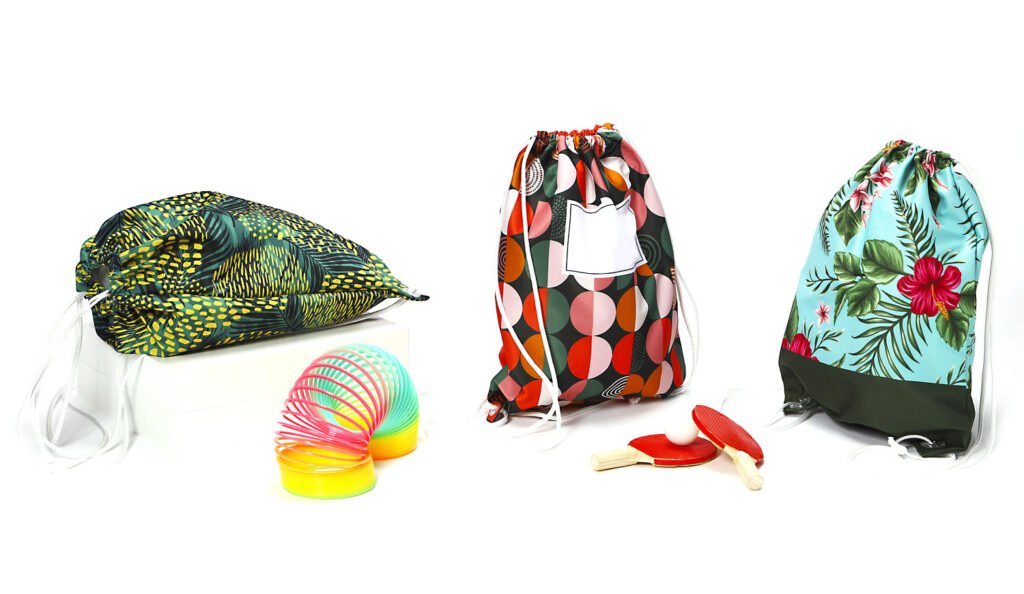
Drawstring backpacks, or cinch bags, are lightweight bags close at the top with a drawstring. These bags are versatile and easy to use, making them popular for various activities. The drawstring closure allows quick access to the contents, and the same strings function as shoulder straps, making the bag easy to carry.
These bags come in polyester, nylon, cotton, and eco-friendly options like recycled PET (RPET). Polyester and nylon are durable and water-resistant, making them ideal for sports and outdoor activities. Cotton and canvas provide a more natural look and feel, appealing to those who prefer eco-friendly products.
Drawstring backpacks are used for many purposes. They are perfect for everyday use, such as personal items, gym clothes, or school supplies. They are also famous for promotional events because they can be easily customized with logos and designs, offering a great way to promote a brand. Their lightweight and foldable nature makes them convenient for travel and outdoor activities.
Drawstring backpacks are valued for their simplicity, functionality, and versatility. Whether for personal use, marketing, or as a practical giveaway item, these bags offer an efficient and stylish solution for carrying essentials.
Chapter 03
What Are the Different Types of Drawstring Bags Available?
Drawstring bags come in various styles and materials, each suited to different needs and preferences. Here’s a detailed breakdown of the types of drawstring bags available:
By Material
- Cotton Drawstring Bags: These are eco-friendly, durable, and easily customized. They are suitable for events, promotions, and everyday use
- Canvas Drawstring Bags: Similar to cotton but sturdier, making them ideal for carrying heavier items and for customization
- Nylon Drawstring Bags: Lightweight, durable, and often water-resistant, making them perfect for sports, gym use, and outdoor activities
- Polyester Drawstring Bags: Known for their durability and resistance to moisture, these bags are versatile and commonly used for promotional purposes
- Burlap and Jute Drawstring Bags: Eco-friendly and durable, often used for rustic-themed events, gift bags, and storage
- Mesh Drawstring Bags: Ideal for carrying items that need ventilation, such as sports gear or produce
By Use
- Sports and Gym Bags
Typically made from nylon or polyester, these bags are designed to be durable and lightweight, often featuring additional pockets and compartments for convenience. - Promotional Bags
Customizable drawstring bags made from various materials like cotton, polyester, or recycled materials, used for branding and giveaways at events. - Travel Bags
These are usually made from durable materials like nylon or polyester and are designed to be compact and easy to carry, suitable for storing essentials during travel. - Gift and Party Favor Bags
Small drawstring pouches made from materials like silk, cotton, or jute used for packaging gifts or party favors. - Insulated Bags
Insulated drawstring bags are designed to keep food and drinks at the desired temperature, making them perfect for picnics or lunch bags.
Specialty Designs
- Reflective and High-Visibility Bags
These bags often feature reflective stripes and are designed for safety, making them suitable for outdoor activities in low-light conditions. - Eco-Friendly Bags
Made from recycled or sustainably sourced materials like RPET (recycled polyethylene terephthalate) or organic cotton, these bags appeal to environmentally conscious consumers. - Novelty and Fashion Bags
These include bags with unique designs, such as tie-dye, camo print, or iridescent finishes, aimed at making a fashion statement.
Drawstring bags are versatile and come in numerous styles and materials to meet various needs, from everyday use to special events and promotional activities.
Chapter 04
What Materials Are used In the Production of Drawstring bags, and What Are Their Pros and Cons?
Drawstring bags can be made from various materials, offering benefits and potential drawbacks. Understanding these materials will help you choose the best type of drawstring bag for your specific needs.

Material:Nylon
Description:Another synthetic material known for its strength and flexibility.
Pros:
- High Strength: Excellent tensile strength, making it suitable for heavy loads.
- Lightweight: Easy to carry, similar to polyester.
- Quick-Drying: Dries faster than most other materials, ideal for sports and outdoor use.
- Resistant to Mold and Mildew: Keeps the bag fresh and hygienic.
Cons:
- Cost: Generally more expensive than polyester.
- Environmental Impact: Also petroleum-based, contributing to plastic waste.

Material:Cotton
Description:A natural fiber known for its softness and breathability.
Pros:
- Eco-Friendly: Biodegradable and often grown without harmful pesticides (especially organic cotton).
- Breathable: Allows air to circulate, reducing the buildup of odors.
- Softness: Comfortable to handle and carry.
- Versatile: Can be dyed in various colors and printed with different designs.
Cons:
- Less Durable: More prone to wear and tear compared to synthetic materials.
- Heavier: Can be bulkier and heavier, especially when wet.
- Shrinkage: May shrink after washing if not pre-treated.

Material:Polyester
Description:A synthetic material commonly used for its durability and versatility.
Pros:
- Durability: Resistant to wear and tear, making it ideal for long-term use.
- Water-resistant: Provides protection against moisture and is suitable for outdoor activities.
- Lightweight: Easy to carry and transport.
- Color Retention: Holds dye well, allowing for vibrant colors and designs.
Cons:
- Not Eco-Friendly: Made from petroleum based products, contributing to environmental pollution.
- Less Breathable: Can retain odors if not cleaned regularly.

Material:RPET (Recycled PET)
Description:Made from recycled plastic bottles, an eco-friendly synthetic material.
Pros:
- Eco-Friendly: Reduces plastic waste and is recyclable.
- Durability: Comparable to new polyester in terms of strength and longevity.
- Lightweight: Easy to carry and transport.
- Customization: Can be dyed and printed with vibrant designs.
Cons:
Cost: Often more expensive than virgin polyester due to the recycling process.
Perceived Quality: Some consumers may perceive it as lower quality than new materials.

Material:Mesh
Description:A lightweight, open-weave material that allows for breathability.
Pros:
Breathability: Allows air to flow, keeping contents dry and fresh.
Lightweight: Extremely light, ideal for carrying sports gear or beach items.
Visibility: Contents are easily visible, which can benefit specific uses.
Quick-Drying: Dries rapidly, suitable for wet environments.
Cons:
- Durability: Less durable than solid fabrics, can tear more easily.
- Limited Use: Not ideal for carrying small or valuable items due to visibility and potential loss.
Chapter 05
How to Choose the Right Material for a Drawstring Bag Backpack?
Choosing the suitable material for your drawstring bag backpack is crucial to ensure it meets your needs in terms of durability, aesthetics, and functionality. Here’s a step-by-step guide to help you make an informed decision:
1.Identify the Purpose of the Bag
The first step in selecting the suitable material is understanding how the bag will be used. Different uses require different material properties:
- Everyday Use
A durable yet lightweight material like polyester or cotton is suitable if the bag is used daily to carry light items.
- Sports and Outdoor Activities
For activities involving exposure to moisture and rough handling, consider materials like nylon or polyester for their water-resistant and durable properties.
- Promotional Events
Cost-effective materials like polyester or non-woven polypropylene are ideal for giveaways and promotional items.
- Eco-Friendly Needs
f sustainability is prioritized, opt for organic cotton, recycled PET (RPET), or jute.
2.Consider the Durability Requirements
The longevity of the bag is directly influenced by the material:
- High Durability
Nylon and canvas are excellent choices for heavy-duty use due to their high tensile strength and resistance to wear and tear.
- Moderate Durability
Polyester balances durability and affordability, making it suitable for general use.
- Low Durability
Materials like mesh or non-woven polypropylene are less durable but lightweight and suitable for specific, less demanding uses.
3.Evaluate the Weight of the Material
The weight of the material affects the overall comfort and usability of the bag:
- Lightweight Materials
Polyester, nylon, and mesh are light and easy to carry, ideal for sports and travel.
- Heavier Materials
Canvas and certain types of thick cotton can be heavier, providing more durability and a premium feel but potentially adding bulk.
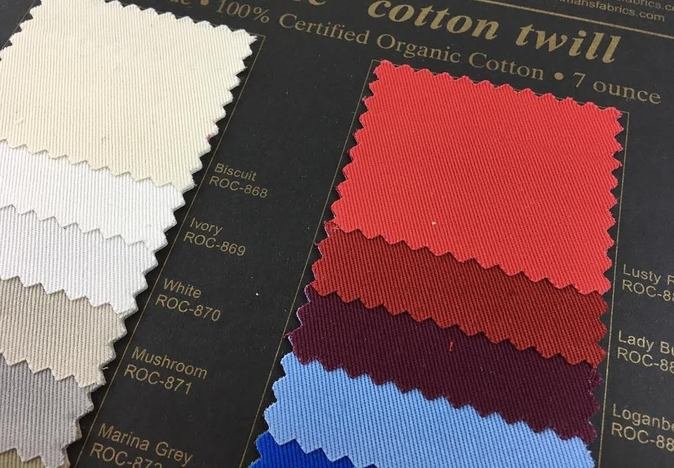
4.Assess Water Resistance Needs
Consider whether the bag will be exposed to moisture:
- Water-Resistant Materials
Nylon and polyester are naturally water-resistant, making them perfect for outdoor and sports activities.
- Non-Water-Resistant Materials
Cotton and canvas absorb water, which can be a drawback unless treated with a water-resistant coating.

5.Determine Aesthetic Preferences
The look and feel of the bag are essential for branding and personal preferences:
- Smooth and Shiny Finish
Polyester and nylon provide a sleek, modern look.
- Natural and Rustic Finish
Cotton, canvas, and jute offer a more organic and earthy appearance.
- Luxury Finish
Velvet and leather are used for high-end, luxurious bags, adding a touch of elegance.
6.Consider Environmental Impact
Sustainability is becoming increasingly important:
- Eco-Friendly Materials
Organic cotton, recycled PET (RPET), and jute are sustainable options that reduce environmental impact.
- Non-Eco-Friendly Materials
Polyester and nylon, while durable, are petroleum-based and have a higher environmental footprint.
7.Budget Constraints
Your budget will significantly influence your choice of material
- Cost-Effective Options
Polyester and non-woven polypropylene are affordable and suitable for bulk orders.
- Mid-Range Options
Cotton and canvas offer a balance between cost and quality.
- Premium Options
Nylon, velvet, and leather are more expensive but provide superior durability and aesthetics.

Choosing the suitable material for your drawstring bag backpack involves balancing your needs for durability, weight, water resistance, aesthetics, environmental impact, and budget. By considering these factors, you can select a material that ensures your drawstring bag backpack is functional and durable and aligns with your personal or brand values. Whether you need a lightweight bag for daily use, a durable option for sports, or an eco-friendly bag for promotional events, there is a material that fits your requirements perfectly.
Chapter 06
What Are the Popular Sizes of Drawstring Bag Backpacks and Their Applications?
Drawstring bag backpacks come in various sizes to cater to different needs and preferences. Here’s a look at the most popular sizes and their specific applications:
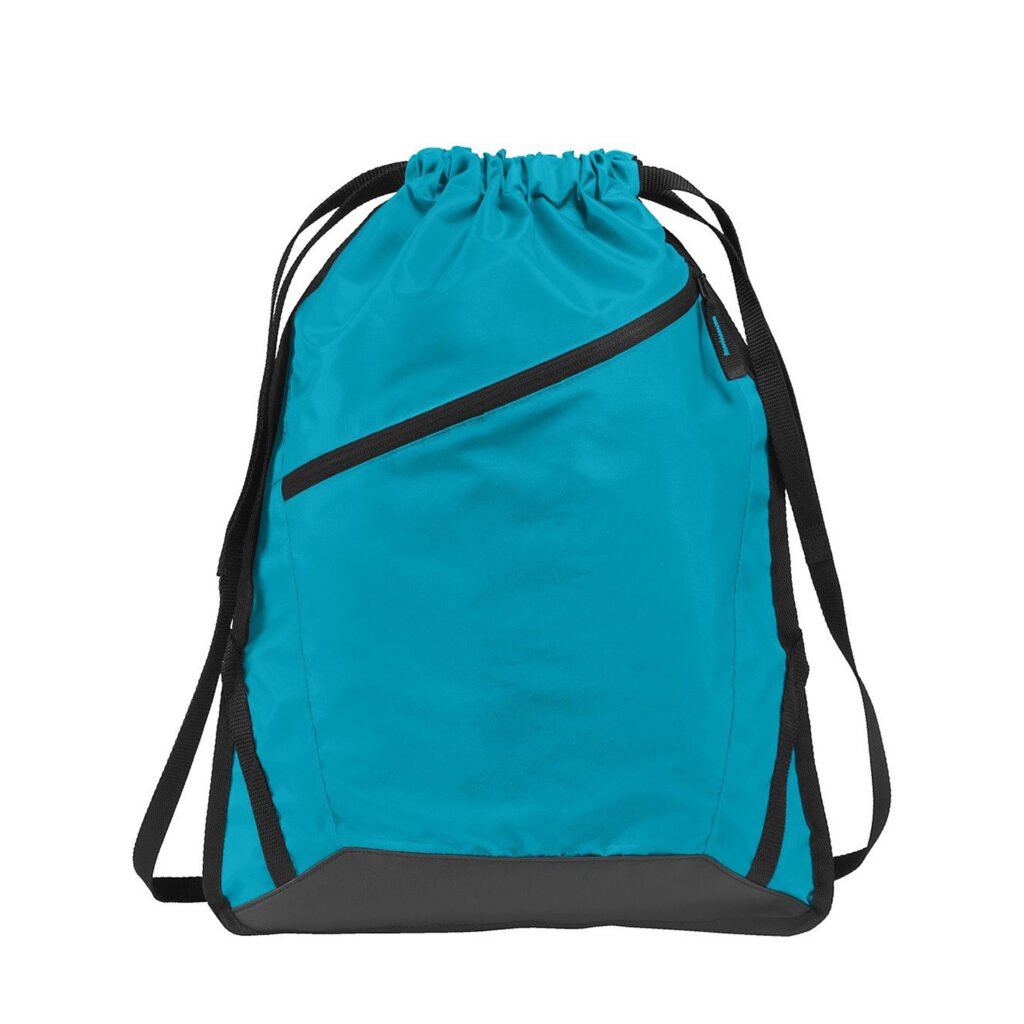
Size:Medium (15″ x 18″)
Popularity:Most popular size
Applications:
- Everyday Use: Ideal for carrying personal items, books, and gym clothes.
- School: Suitable for students to carry textbooks, notebooks, and other school essentials.
- Promotional Events: Widely used for branding and giveaways due to its versatile size and ample printing area.
- Day Trips: Perfect for short outings, providing enough space for snacks, water bottles, and other necessities.
Pros:
- Balanced size offers good capacity without being too bulky.
- Lightweight and easy to carry.
Cons:
- May not hold larger items.
- Limited to moderate storage capacity.

Size:Small (12″ x 16″)
Popularity:Popular for specific, lighter use cases.
Applications:
- Children’s Bags: Great for kids to carry their lunch, small toys, or school supplies.
- Promotional Giveaways: Cost-effective choice for events where attendees receive small gifts or samples.
- Product Packaging: Used by companies to package smaller items attractively
Pros:
- Compact and lightweight.
- Easy to store and transport.
Cons:
- Limited capacity, not suitable for larger items.

Size:Large (18″ x 24″)
Popularity:Preferred for heavy-duty and travel purposes.
Applications:
- Sports Gear: Can accommodate larger sports equipment like balls, shoes, and uniforms .
- Travel Bags: Ideal for carrying clothes, shoes, and travel essentials.
- Camping and Outdoor Activities: Provides ample space for camping gear and supplies.
Pros:
- High storage capacity.
- Durable and suitable for heavier loads.
Cons:
- Can be bulky and heavier to carry.

Size:Extra-Large (20″ x 28″ and above)
Popularity:Used for specialty applications requiring maximum capacity.
Applications:
- Laundry Bags: Commonly used in dormitories and homes for storing and transporting laundry.
- Event Supplies: Used to carry bulk supplies and equipment for significant events and gatherings.
- Heavy-Duty Applications: Suitable for industrial or commercial uses where large capacity and durability are essential.
Pros:
- Maximum storage capacity.
- Suitable for heavy-duty use.
Cons:
- Very bulky and can be cumbersome to carry.
- Not ideal for everyday use due to its size.
Chapter 07
What Customization Options Are Available for Drawstring Bags?
Customization options for drawstring bags are vast and varied, allowing you to tailor the bags to your specific needs, whether for branding, promotional events, or personal use. Here’s an in-depth look at the customization possibilities:
Printing Techniques
Printing is one of the most common customization methods, offering a variety of techniques to apply logos, text, and designs to the bags:

Screen Printing
- Description: A traditional method where ink is pushed through a stencil (screen) onto the fabric.
- Pros: Cost-effective for bulk orders, vibrant colors, durable print.
- Cons: Limited to simple designs with fewer colors, setup costs can be high for small orders.

Digital Printing
- Description: Digital technology is used to print designs directly onto the fabric.
- Pros: Ideal for complex, multi-color designs, no setup costs, suitable for small orders.
- Cons: Typically more expensive per unit than screen printing, less durable for heavy use.
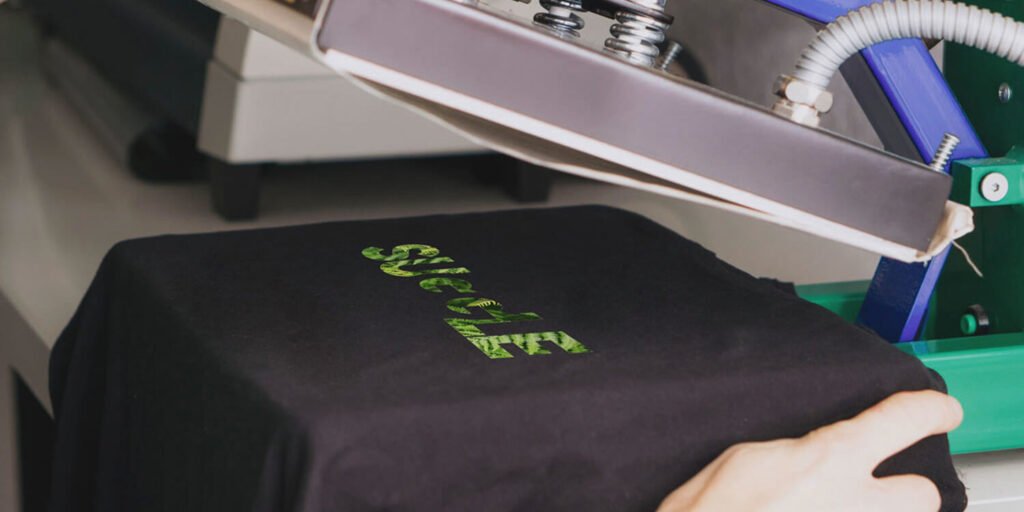
Heat Transfer
- Description: Transfers designs from a printed film onto the fabric using heat and pressure.
- Pros: Good for detailed and multi-color designs, flexible regarding fabric types.
- Cons: Can peel or crack over time, especially with frequent washing.

Embroidery
- Description: Uses thread to stitch designs onto the fabric.
- Pros: High-end, professional look, very durable.
- Cons: More expensive, especially for complex designs, limited to fewer colors.
Material Choice
Choosing the material is a key aspect of customization that affects the bag’s look, feel, and functionality:
Polyester
- Durable, water-resistant, lightweight, holds vibrant colors well.
- Available in various colors, suitable for screen and digital printing.
Nylon
- Benefits: Strong, flexible, water-resistant, quick-drying.
- Customization: Available in various colors, works well with screen printing and embroidery.
Jute
- Benefits: Eco-friendly, strong, biodegradable, natural texture.
- Customization: Ideal for screen printing, available in natural hues and can be dyed.

Cotton
- Benefits: Natural, breathable, eco-friendly.
- Customization: Ideal for screen printing and embroidery, available in natural and dyed colors.
Canvas
- Benefits: Heavy-duty, durable, natural appearance.
- Customization: Suitable for screen printing and embroidery, often available in natural and dyed colors.
RPET (Recycled PET)
- Benefits: Eco-friendly, durable, similar to polyester.
- Customization: Supports most printing methods and is available in various colors.
Color Options
Customizing the color of the bag itself can make a big impact:
- Solid Colors: Choose various colors to match your brand or event theme.
- Two-Tone: Combine two colors for a unique and eye-catching design.
- Patterned Fabrics: Opt for fabrics with pre-printed patterns or designs for a distinct look.

Additional Features
Enhance the functionality and appeal of the drawstring bags with additional features:
Pockets and Compartments
- Internal Pockets: Add internal pockets for better organization of small items.
- External Pockets: Include zippered or open pockets on the exterior for easy access.
Zippers
- Main Compartment Zipper: Secure the main compartment with a zipper instead of the traditional drawstring closure.
- Side Zippers: Add side zippers for additional access points and convenience.

Reinforced Corners
- Description: Strengthen the corners with additional fabric or grommets to enhance durability.
- Benefits: Increases the bag’s lifespan, particularly useful for heavy-duty use.
Adjustable Straps
- Description: Include adjustable straps to improve comfort and fit.
- Benefits: It makes the bag more versatile for users of different sizes.
Drawstring Material
- Variety: Choose from different materials for the drawstrings, such as cotton, nylon, or reflective material for added safety.
Size and Shape
Customize the dimensions of the bag to suit specific needs:
- Standard Sizes: Common sizes like 12″ x 16″, 15″ x 18″, and 18″ x 24″.
- Custom Sizes: Specify unique dimensions to fit particular items or requirements.
- Shapes: Traditional rectangular shapes or more unique shapes like circular or triangular designs.

Branding Elements
Incorporate branding elements to make the bag uniquely yours:
- Logos: Place your company logo prominently on the bag.
- Taglines: Add your brand’s tagline or a promotional message.
- Contact Information: Include your website, phone number, or social media handles for easy reference.

Eco-Friendly Options
Promote sustainability with eco-friendly customization options:
- Organic Materials: Use organic cotton or other sustainable materials.
- Recycled Materials: Opt for fabrics made from recycled content, like RPET.
- Eco-Friendly Inks: Use water-based or eco-friendly inks for printing.

Customized services
We provide insights into current styles and consumer preferences, ensuring your custom bag is not only personalized but also contemporary and market-relevant.
Chapter 08
What Are the Key Steps Involved in the Manufacturing of Drawstring Bags?
Manufacturing drawstring bags involves several key steps, from initial design to final production. Here’s an overview of the process:

Design and Planning
- Concept Development: The process begins with developing the bag’s design, including the size, shape, and features such as pockets, zippers, or reinforced corners.
- Material Selection: Choosing the appropriate material is crucial. Options include polyester, nylon, cotton, canvas, and recycled materials like RPET, depending on the bag’s intended use and desired durability.
- Prototype Creation: A prototype or sample is created based on the design specifications to ensure the bag meets all functional and aesthetic requirements.
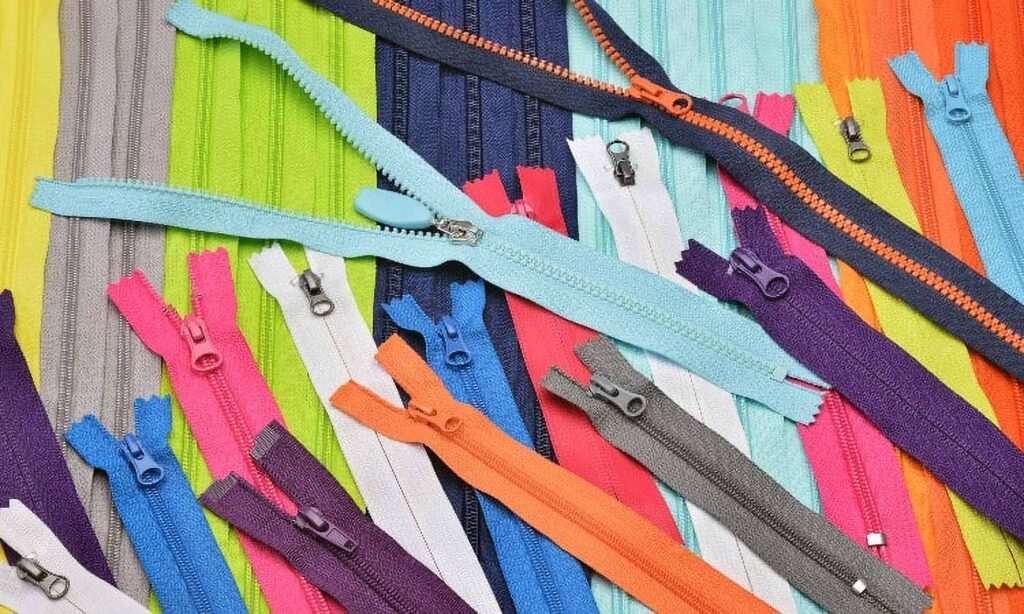
Material Procurement
- Sourcing Materials: The necessary materials, including fabric, drawstrings, eyelets, and other components, are sourced from suppliers.
- Quality Check: Materials undergo a quality check to ensure they meet the required standards for durability, colorfastness, and overall quality.

Cutting
- Fabric Cutting: The fabric is cut into the required shapes and sizes using cutting machines or templates. This includes the bag’s main body, additional pockets, and reinforcement patches.
- String and Accessory Preparation: Drawstrings, zippers, and other accessories are measured and cut to size.

Printing and Customization
- Design Application: Logos, designs, or other custom graphics are applied to the fabric using techniques such as screen printing, digital printing, heat transfer, or embroidery.
- Drying and Setting: After printing, the fabric is dried, and the designs are set to ensure durability and prevent fading.
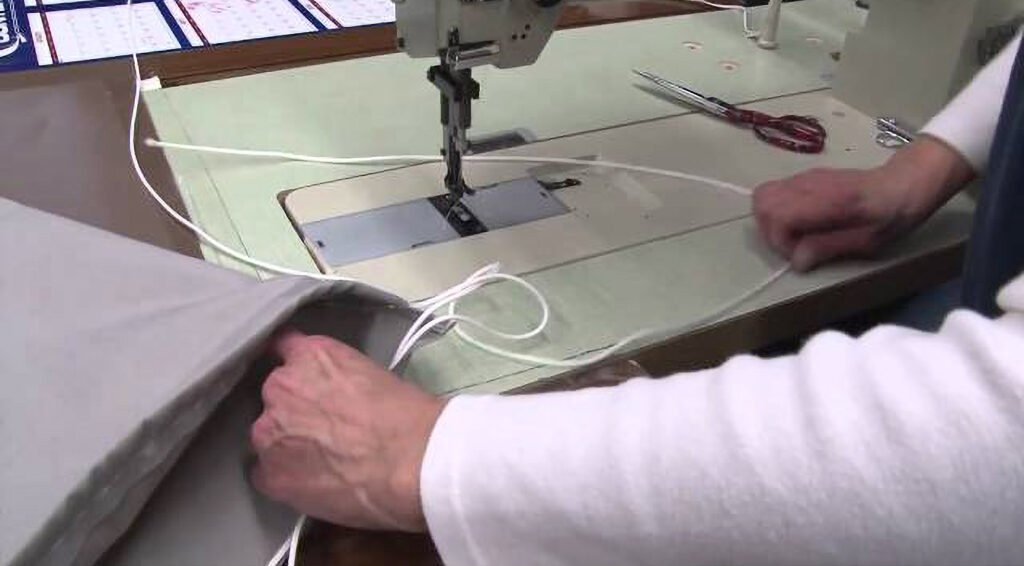
Sewing and Assembly
- Stitching the Bag: The cut fabric pieces are sewn together using industrial sewing machines. This includes attaching the front and back panels, sewing additional pockets, and reinforcing corners or stress points.
- Inserting Drawstrings: The drawstrings are threaded through the top hem or eyelets of the bag, which will serve as both the closure mechanism and shoulder straps.
- Attaching Accessories: Any additional accessories, such as zippers, toggles, or reinforcement patches, are attached.

Quality Control
- Inspection: Each bag undergoes a thorough inspection to check for defects in stitching, printing, and overall construction. This ensures that the bags meet the required quality standards.
- Testing: Bags may be subjected to functional tests, such as stress tests on the drawstrings and seams, to ensure they can withstand regular use.

Packaging
- Folding and Packing: The finished bags are folded and packed according to the client’s specifications. This might include individual poly bags, bulk packaging, or custom packaging solutions.
- Labeling: Each package contains relevant information such as quantity, size, and design details.

Shipping
- Logistics Coordination: Arrangements are made for the bags to be shipped to their final destination. This involves coordinating with shipping companies and ensuring all necessary documentation is prepared.
- Delivery: The bags are delivered to the client or distribution center and ready for sale or use.
Manufacturing drawstring bags is a detailed process that involves careful planning, material selection, precise cutting, customization, and thorough quality control. Each step is crucial to ensure that the final product meets the desired functionality, durability, and aesthetic appeal standards. By following these key steps, manufacturers can produce high-quality drawstring bags that fulfill various needs and preferences.
Chapter 09
How Can We Ensure the Quality of the Drawstring Bags for Your Order?
1.Choose a Reputable Supplier
Selecting a reliable and reputable supplier is the first step in ensuring product quality:
- Research: Look for suppliers with positive reviews, industry certifications, and a proven track record.
- References: Ask for references from other clients who have ordered similar products.
- Certifications: Check if the supplier holds relevant certifications such as ISO 9001 (Quality Management) or ISO 14001 (Environmental Management).


2.Specify Detailed Requirements
Providing detailed specifications can prevent misunderstandings and ensure you get exactly what you expect:
- Material Specifications: Clearly state the type and grade of material used (e.g., 210D polyester, organic cotton, RPET).
- Size and Dimensions: Provide precise measurements for the bag and additional features like pockets or compartments.
- Printing Details: Include specifications for printing methods (screen printing, digital printing), colors, and placement of logos or designs.
- Construction Requirements: Detail the type of stitching, reinforcements, and drawstring materials you expect.
3.Request Samples
Before placing a large order, always request samples:
- Evaluate Quality: Inspect the sample for material quality, stitching, printing, and overall craftsmanship.
- Test Durability: Conduct tests such as pulling on the drawstrings, checking the strength of seams, and assessing the durability of any printed designs.
- Compare Suppliers: If you’re considering multiple suppliers, request samples from each and compare them.


4.Implement Quality Control Checks
Quality control checks are essential throughout the production process:
- Pre-Production Sample: Approve a pre-production sample that matches your specifications before mass production begins.
- In-Process Inspections: Arrange for inspections during different stages of production to catch any issues early.
- Final Inspection: Conduct a thorough final inspection before the products are shipped. This can include checking a percentage of the order randomly to ensure consistency.
5.Use Third-Party Quality Assurance Services
Consider hiring a third-party quality assurance service to oversee the production process:
- Inspection Services: Companies like SGS, Bureau Veritas, or Intertek provide inspection and quality assurance services that can audit the factory and check the products on your behalf.
- Factory Audits: A third-party audit can verify that the factory adheres to good manufacturing practices and meets your quality standards.


6.Establish Clear Communication
Maintaining clear and constant communication with your supplier can prevent misunderstandings and ensure smooth production:
- Regular Updates: Request regular updates and progress reports from the supplier.
- Direct Contacts: Have a direct point of contact within the supplier’s team to address any issues promptly.
- Language Barriers: Be aware of potential language barriers and use clear, simple language or professional translation services if needed.
7.Agree on Quality Standards
Set clear quality standards and include them in the purchase agreement:
- Quality Parameters: Define acceptable quality parameters, such as material weight, color fastness, and tensile strength of the drawstrings.
- Tolerance Levels: Specify acceptable tolerance levels for any size, color, or construction variations.
- Defect Rates: Agree on acceptable defect rates and the procedure for handling defective products.


8.Implement a Return and Refund Policy
Have a clear return and refund policy in place to address any quality issues:
- Inspection Period: Define when to inspect the goods and report any defects.
- Return Process: Outline the process for returning defective items and receiving replacements or refunds.
- Warranty: Consider including a product warranty to cover any defects that arise after delivery.
9.Conduct Post-Delivery Inspections
Even after the products arrive, conducting a final inspection is important:
- Random Sampling: Check a random sample of the delivered goods to ensure they meet your quality standards.
- Functionality Tests: Test the drawstrings, zippers, and other features to ensure they work correctly.
- Visual Inspection: Look for visible defects, such as poor stitching, inconsistent printing, or damaged materials.

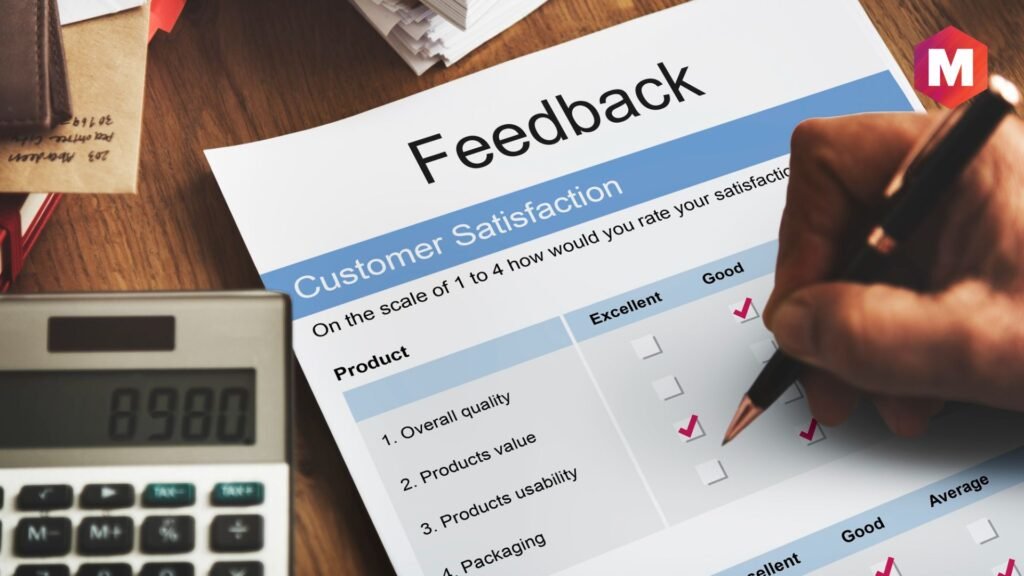
10.Gather Feedback and Continuously Improve
Gather feedback from your end-users and continuously improve your quality control processes:
- Customer Feedback: Solicit feedback from customers about the quality of the drawstring bags.
- Supplier Feedback: Share any quality issues with your supplier to help them improve future production.
- Quality Audits: Regularly review and update your quality control procedures to incorporate new insights and best practices.
Ensuring the quality of your drawstring bags involves a comprehensive approach that starts with choosing the right supplier and continues through detailed specifications, rigorous quality checks, and post-delivery inspections. By following these steps and maintaining clear communication with your supplier, you can significantly reduce the risk of receiving substandard products and ensure that your drawstring bags meet your high standards for quality and durability.
Chapter 10
What Are the Cost Considerations When Ordering Drawstring Bags in Bulk?
Ordering drawstring bags in bulk can be a cost-effective way to meet your needs, whether for promotional events, retail, or organizational use. However, several factors can influence the total cost. Here’s an in-depth look at the key cost considerations:
1.Material Costs
The type of material used in the drawstring bags significantly affects the price:
- Polyester: Generally cost-effective, durable, and widely used for standard drawstring bags.
- Nylon: Slightly more expensive than polyester due to its superior strength and flexibility.
- Cotton: Natural and eco-friendly, with prices varying based on whether it’s organic or conventional cotton.
- Canvas: A heavy-duty option that is more costly but offers enhanced durability.
- RPET (Recycled PET): An eco-friendly choice that may be more expensive due to the recycling process.

2.Customization Costs
Customization adds value to the drawstring bags but also increases costs:
- Screen Printing: Cost-effective for bulk orders with simple designs.
- Digital Printing: Higher per-unit cost but allows for complex, multi-color designs.
- Heat Transfer: Good for detailed designs but can be more expensive.
- Embroidery: Adds a premium look and durability but is generally the most costly option.
- Design Complexity: More intricate designs require more time and resources, increasing costs.
- Number of Colors: Each additional color in the design can add to the cost, especially with screen printing.
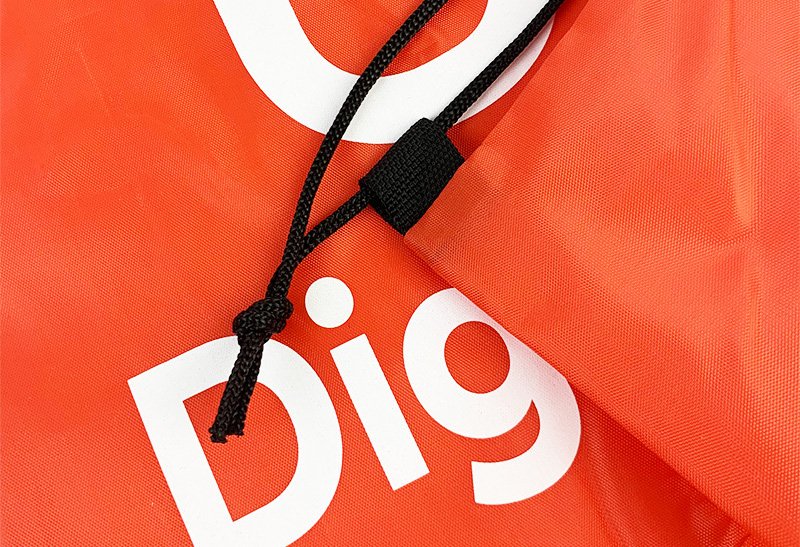
3.Quantity Ordered
Bulk ordering typically reduces the per-unit cost due to economies of scale:
- Price Breaks: Suppliers often offer discounts at certain quantity thresholds (e.g., 500, 1,000, 5,000 units).
- Minimum Order Quantities (MOQ): Be aware of the supplier’s MOQ, the smallest quantity they are willing to produce and sell at the bulk rate.
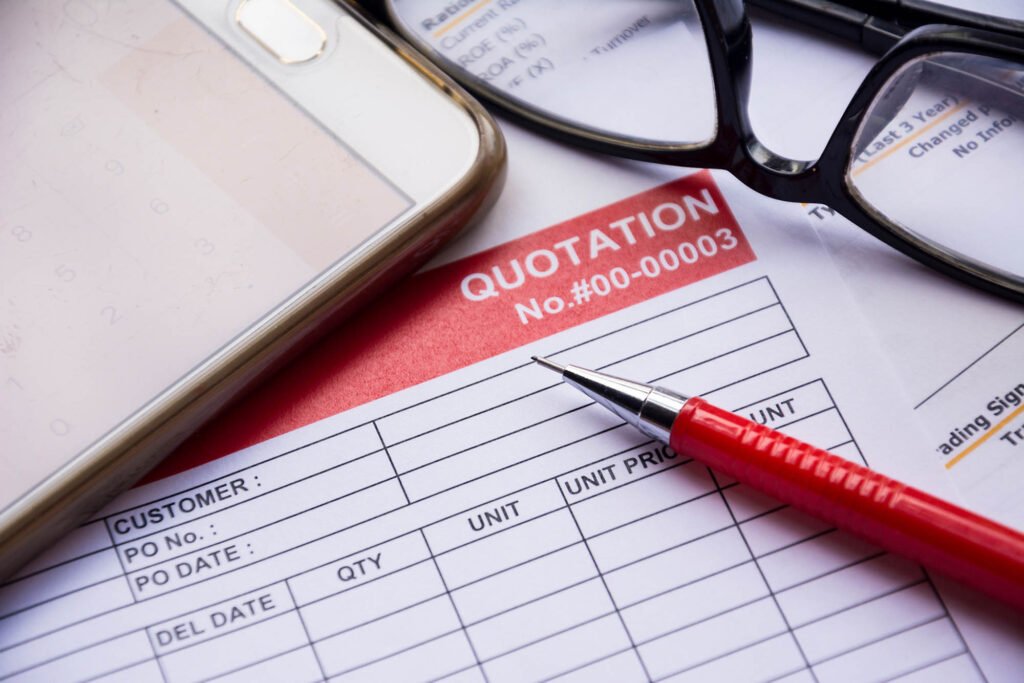
4.Shipping and Logistics
Shipping costs can significantly impact the overall expense, especially for international orders:
- Weight and Volume: Larger and heavier shipments cost more to transport.
- Shipping Method: Air freight is faster but more expensive than sea freight, which is cheaper but slower.
- Customs and Duties: For international orders, factor in customs fees, import duties, and taxes.
- Insurance: Consider shipping insurance to protect against loss or damage during transit.

5.Production Lead Time
The production timeline can affect costs:
- Standard Production: Generally more cost-effective with a longer lead time.
- Rush Orders: Expedited production can significantly increase costs due to the need for overtime labor and faster processing.

6.Quality Control
Investing in quality control can prevent costly mistakes and ensure the final product meets your standards:
- Pre-Production Samples: Ordering samples before mass production ensures you approve the quality and design, though it adds an initial cost.
- Third-Party Inspections: Hiring a third-party inspection service adds to the cost but can help avoid more considerable expenses from defective products.

7.Packaging
The type and quality of packaging also contribute to the overall cost:
- Primary Packaging: Standard packaging options are usually included in the base cost.
- Custom Packaging: Branded or high-quality packaging can add to the per-unit cost but enhance the product’s presentation and value.

8.Supplier Location
The geographic location of the supplier can influence costs:
- Local Suppliers: This may offer faster turnaround times and lower shipping costs but can be more expensive in labor and material costs.
- Overseas Suppliers: Often provide lower production costs but with higher shipping costs and longer lead times
9.Additional Features
Adding extra features to your drawstring bags increases their functionality and appeal but also adds to the cost:
- Pockets and Zippers: Additional compartments and closures add to the material and labor costs.
- Reinforced Corners: Enhances durability but requires extra materials and sewing time.
- Adjustable Straps: These are more comfortable for users but are more complex to manufacture.

10.Supplier Negotiations
Effective negotiations with suppliers can help manage costs:
- Bulk Discounts: Negotiate better rates for larger orders.
- Long-Term Contracts: Committing to long-term or repeat orders can sometimes secure better pricing.
- Payment Terms: Discuss payment terms that offer a discount for upfront or early payments.

11.Balancing Cost and Quality
While it’s essential to manage costs, balancing them with quality is crucial to ensure customer satisfaction and product durability:
- Cost vs. Value: Consider the long-term value and durability of the bags rather than just the initial cost.
- Quality Assurance: Invest in quality control to avoid the higher costs associated with returns, refunds, and customer dissatisfaction.

When ordering drawstring bags in bulk, various factors influence the total cost. You can make informed decisions that balance cost with quality by understanding and managing these considerations—material choices, customization, quantity, shipping, production lead times, quality control, packaging, supplier location, additional features, and effective negotiations. This strategic approach ensures you receive high-quality drawstring bags that meet your needs and budget, providing maximum value for your investment.
Chapter 11
How do we Choose the Right Drawstring Bag for Different Purposes?
Choosing the right drawstring bag for different purposes involves considering several factors to ensure the bags meet the specific needs and preferences of the target audience. Here’s a detailed guide to help you select the appropriate drawstring bag for various uses, such as promotional events, retail, and giveaways.
1.Promotional Events
Promotional events require drawstring bags that effectively showcase your brand while being practical for attendees.
Material
- Polyester: Cost-effective, durable, and ideal for printing vibrant logos.
- Cotton: Offers a natural look and feel, suitable for eco-conscious brands.
- RPET (Recycled PET): Eco-friendly option that aligns with sustainable branding efforts.
Customization:
- Large Printing Area: Ensure the bag has a sizable area for your logo and promotional messages.
- Vibrant Colors: Choose colors that reflect your brand and attract attention.
- Event-Specific Designs: Customize the design to match the theme of the event.
Size:
- Medium (15″ x 18″): Provides ample space for attendees to carry brochures, samples, and other event materials.
- Small (12″ x 16″): Suitable for lightweight items and easy to carry around during the event.
Features
- Reinforced Corners: Adds durability, especially if the bag will be used repeatedly.
- Comfortable Straps: Ensures attendees can carry the bag comfortably throughout the event.
2.Retail
Retail drawstring bags should be appealing, durable, and versatile, enhancing the customer’s shopping experience.
Material:
- Canvas: Durable and provides a premium feel, ideal for high-end retail.
- Cotton: Soft and natural, perfect for brands focusing on sustainability.
- Nylon: Strong and flexible, suitable for carrying heavier items.
Customization:
- Branding: Incorporate your store’s logo, tagline, and design elements to reinforce brand recognition.
- Quality Printing: Use high-quality printing techniques like screen printing or embroidery for a polished look.
Size:
- Medium to Large (15″ x 18″ or 18″ x 24 “): Ensures enough space for customers to carry purchased items, from clothing to accessories.
Features
- Pockets: Add internal or external pockets for better organization of smaller items.
- Zippers: Include zippers for added security and convenience.
Customization:
Simple Designs: Keep designs straightforward to reduce costs while ensuring brand visibility.
Logo Placement: Make sure the logo is prominently displayed for maximum exposure.
Size:
- Small to Medium (12″ x 16″ or 15″ x 18 “): Sufficient for carrying small items, making it a practical gift.
Features
Lightweight: Easy to carry, enhancing the recipient’s experience.
Basic Construction: Focus on essential features to keep costs down while maintaining functionality.
Customization:
- Team Logos and Colors: Customize with team logos and colors for a cohesive look.
- Reflective Elements: Add reflective strips for visibility and safety during outdoor activities.
Size:
- Large (18″ x 24″): Provides ample space for sports equipment, shoes, and clothing.
Features
- Ventilation: Include mesh panels or holes to prevent odors and moisture buildup.
- Reinforced Straps and Corners: Ensure the bag can withstand heavy use and carry heavy items.
Customization:
- Travel-Friendly Designs: Opt for designs with travel-related themes or your travel agency’s branding.
- Personalization: Offer personalized options like adding the traveler’s name or initials.
Size:
- Significant to Extra-Large (18″ x 24″ or larger): Ensures enough space for clothes, toiletries, and other travel essentials.
Features
- Multiple Compartments: Helps organize different travel items efficiently.
- Drawstring and Zipper Combination: Provides added security for travel items.
Choosing the right drawstring bag for different purposes involves understanding the specific needs of each use case. For promotional events, focus on cost-effective materials with ample customization options. In retail, prioritize durability and aesthetic appeal to enhance the shopping experience. For giveaways, opt for practicality and affordability. Sports and outdoor activities demand robust, water-resistant materials and additional features for functionality. Travel bags should be spacious and durable, with features that facilitate organization and security. Considering these factors, you can select the perfect drawstring bag that meets your needs and exceeds your expectations.
Tell Us What You Need — We’ll Take Care of the Rest!
Let us know your specific requirements, and our team will get back to you with a tailored solution. We look forward to working with you!








